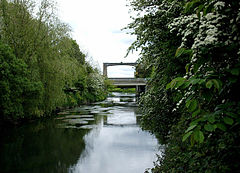Orgreave, South Yorkshire
| Orgreave | |
|---|---|
 The River Rother at Orgreave |
|
| Orgreave shown within South Yorkshire | |
| Population | 739 (2011 Census) |
| OS grid reference | SK425860 |
| Civil parish |
|
| Metropolitan borough | |
| Metropolitan county | |
| Region | |
| Country | England |
| Sovereign state | United Kingdom |
| Post town | Sheffield |
| Postcode district | S13 |
| Police | South Yorkshire |
| Fire | South Yorkshire |
| Ambulance | Yorkshire |
| EU Parliament | Yorkshire and the Humber |
| UK Parliament | |
Orgreave is a village and civil parish on the River Rother in South Yorkshire. It is in the Metropolitan Borough of Rotherham, about 4.5 miles (7 km) east of the centre of Sheffield and a similar distance south of the centre of Rotherham.
The 2011 Census recorded its population as 739. This is a slight decline since the 2001 Census, which recorded its population as 761.
Coal mining in the area began with Dore House Colliery in 1820. The first shaft of Orgreave Colliery was sunk in 1851. In the 20th century the Orgreave Coking Plant was established, and the colliery began to supply the plant. The National Coal Board closed Orgreave Colliery in 1981.
In the 1984–85 Miners' Strike, National Union of Mineworkers members picketed the coking plant to prevent employees and coal from entering or products from leaving. On 18 June 1984, three and a half months into the strike, a large number of South Yorkshire Police officers, including mounted units, were deployed against the pickets. There was large-scale violence between police and pickets, which became known as the Battle of Orgreave.
The coking plant closed in 1991. In 1995 British Coal Opencast was authorised to remove the spoil tip of the former colliery and conduct opencast coal mining on a site totalling 700 acres (280 ha). BCO removed some 12 million tonnes of spoil, extracted coal from it, and also realigned almost 3⁄4 mile (1.2 km) of the River Rother. In 2005 BCO completed its work at Orgreave and handed over the land for redevelopment.
...
Wikipedia

